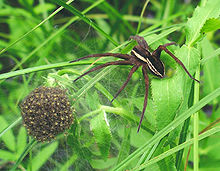This article needs additional citations for verification. (September 2017) |
| Dolomedes | |
|---|---|

| |
| Raft spider (D. fimbriatus) female with juvenile spiders | |
| Scientific classification | |
| Domain: | Eukaryota |
| Kingdom: | Animalia |
| Phylum: | Arthropoda |
| Subphylum: | Chelicerata |
| Class: | Arachnida |
| Order: | Araneae |
| Infraorder: | Araneomorphae |
| Family: | Pisauridae |
| Genus: | Dolomedes Latreille, 1804[1] |
| Species | |
| Diversity[1] | |
| c. 101 species | |
| Synonyms | |
| |
Dolomedes /dɒləˈmiːdiːz/ is a genus of large spiders of the family Pisauridae. They are also known as fishing spiders, raft spiders, dock spiders or wharf spiders. Almost all Dolomedes species are semiaquatic, with the exception of the tree-dwelling D. albineus of the southeastern United States. Many species have a striking pale stripe down each side of the body.
They hunt by waiting at the edge of a pool or stream, then when they detect the ripples from prey, they run across the surface to subdue it using their foremost legs, which are tipped with small claws; like other spiders they then inject venom with their hollow jaws to kill and digest the prey. They mainly eat insects, but some larger species are able to catch small fish. They can also climb beneath the water, when they become encased in a silvery film of air. "Dolomedes" is derived from the Greek word "δολομήδης" which means wily, deceitful.[2]
There are over a hundred species of Dolomedes throughout the world; examples include Dolomedes aquaticus, a forest-stream species of New Zealand, the raft spider (D. fimbriatus), which lives in bogs in Europe, and the great raft spider (D. plantarius), which lives in fens, also in Europe. Many species are large, some with females up to 26 mm (1.0 in) long with a leg span of 80 mm (3.1 in).[3]